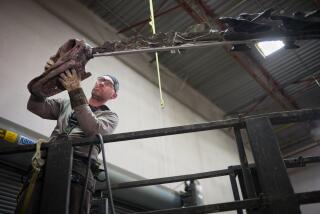Ongoing Fascination With the Dinosaur
- Share via
Looking thoroughly pleased, the Camarasaurus hatchling rests its clawed hands against the eggshell that still holds the rest of its body. Obviously delighted with William Stout’s 1981 painting, children as young as 4 and 5 explain patiently that some dinosaurs hatched, just like chickens. Some even suggest that these dinosaurs may have been the ancestors of all living birds. Throughout the “Dinosaurs Past and Present” exhibition at the L. A. County Museum of Natural History, youngsters roll off multisyllabic names like Triceratops and Allosaurus, displaying an awesome amount of paleontological lore.
Giant fossil bones, believed to be dragon’s teeth in some cultures, captured our imaginations even before anyone knew what they really were. The antiquity of dinosaurs, reptiles that roamed the Earth for a period of 160 million years beginning about 248 million years ago, could not be understood until humanity discovered time. Before that, as John Noble Wilford points out in his engaging narrative, “The Riddle of the Dinosaur” (Knopf, 1985), clerics insisted that the Garden of Eden had been created only 4,000 years earlier. It took a revolution in the world views of geologists and zoologists to create a science of paleontology--a term coined in 1838 to describe the study of ancient beings. Only then could the fossil bones of dinosaurs be recognized for what they are.
By the mid-19th Century, however, the leap had been made. Laypeople and scientists alike began digging for and collecting dinosaur bones. They found some in Europe and China, but the richest fossil beds then, and now, are in North America.
The end of the 19th Century witnessed the “great bone wars” between rich American paleontologists who wanted to stock their respective museums in New Haven, Conn., and New York City. It was also the beginning of successful collaborations between scientists and artists at those museums to make sense out of what they had acquired.
The bones, usually incomplete skeletons, and occasional fossilized skin castings cried out for flesh and color. These were provided by sculptors and painters who figured out where muscle and sinew belonged and what grasses and trees might have provided them shade and food. These earliest artists created images of drab, plated giants that lived in endless swamps.
There is no doubt that the sheer size of these extinct creatures fascinates adults and children alike. The 72-foot-long Mamenchisaurus skeleton from China at the center of the new exhibition draws a constant crowd of gawkers. The announcement of each newly discovered giant, from Triceratops to Tyrannosaurus Rex, has never failed to gain enormous attention.
Today’s paleontologists, however, have shifted their gaze. Still awed by the individual giants, they are equally intrigued with the whole world of the dinosaurs. Scientists are now applying the new approaches of evolutionary biology to re-examine dinosaurs in the light of their courtship behavior, family relations and the part each species played in the total ecological structure of its time.
The scientific focus has changed but paleontologists are still working alongside artists. They collaborate with people like Stephen Czerkas, whose model of a newly discovered Carnotaurus (meat-eating bull) shows horns that may have functioned in male-to-male combat.
Sylvia Czerkas, curator of the exhibition, has successfully depicted visually the enormous intellectual change of the last century in our understanding of the Mesozoic world, a world without large mammals. The newest paintings show terrain crowded with at least 340 different genera of dinosaurs. From the giant Brontosaurus to creatures no bigger than crows, dinosaurs filled every ecological niche, in a way analogous to the marsupial population on the continent of Australia.
Many dinosaurs bore little resemblance to today’s reptiles. Complicated creatures, some were herbivores, others carnivores--their teeth and bones reveal their diets--even cannibals (an adult egg-laying Coelophysis has been found with the bones of an infant of its own species inside) and others care-giving parents. The recent unearthing of whole buried herds reveals that duckbill dinosaurs grew from an egg to a three-ton adult in just a few years, much faster than living crocodiles. Moreover, while some dinosaurs moved on four legs, their bodies horizontal to the ground, others walked upright, and fast. And a new site in Nova Scotia reveals dinosaur footprints the size of a penny, heightening the competition today to recover the fossils of this smallest of all dinosaurs.
Young visitors to the museum take these discoveries in stride. They adore the giants, but love the babies too. Whatever the attraction, there is some special bond between children and dinosaurs. The youngsters gobble up statistics and nomenclature and delight in all the wonderful detail.
Most of them will move on to other interests, but a special few will remain entranced. Here are the paleontologists and artists of the future. For the artists represented in this remarkable exhibition share a childhood obsession that they never outgrew: to learn everything they could about life on a long-vanished Earth.
More to Read
The biggest entertainment stories
Get our big stories about Hollywood, film, television, music, arts, culture and more right in your inbox as soon as they publish.
You may occasionally receive promotional content from the Los Angeles Times.










